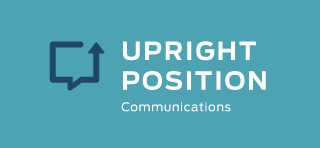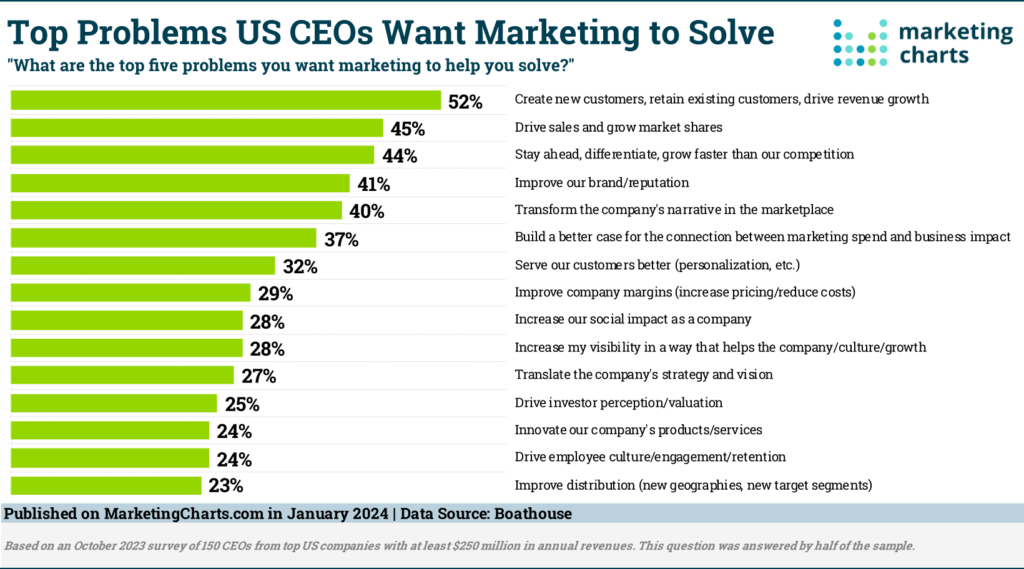Every CMO wants the approval and admiration of their CEO. But what do CEOs really want from marketers? Today, we found a cool chart from marketingcharts.com that shared the top problems US CEOs want marketing to solve.
The first two deal with increasing sales and revenue. While PR and Marketing are “two peas in a pod,” these two deal more with marketing tactics than PR strategy, even though PR often enhances those sales results. (Watch our Uptake on the difference between marketing and PR here.) The next three problems on the chart more closely relate to PR – differentiation from the competition, improving brand and reputation and transforming the company’s narrative in the marketplace. That’s what we’ll tackle here.
Decoding the CMO Archetypes
Our experience finds CEOs usually fall into three buckets. There’s the CMO with a heavy sales and lead gen focus. They’re the toughest CMOs for PR people because they view PR differently than we do and expect PR results to happen as quickly as a marketing campaign.
The next type of CMO is very brand-focused. They’re traditional marketers focused on brand awareness and promoting ad campaigns, brand and image placement, and all those things that get the brand out. They usually understand what PR can do to help build the brand and that it’s not an instant lead-generation tool. They also grasp the importance of a strategic narrative and a vision that happens over time.
The third type of CMO focuses on business, sales leads and branding. They have a more holistic view of marketing and tend to understand PR’s role in the mix. We understand why CMOs are intensely focused on driving revenue, acquiring new customers, and bringing in sales—their boss wants them to do that. But it’s nice when they take a holistic view because solving the next three problems on the chart requires more of a long game, and that’s where PR can help.
PR and the Art of Differentiation
First, let’s consider solving issues with differentiation, something great public relations strategies consider. How do we talk about the company, or how do we talk about a product in a way that differentiates their offering from the competition? While it’s important to understand the competition’s messages and what makes them unique, comparing organizations and copying the competition is tempting, especially if they’re bigger and more successful.
We focus our efforts on conveying differentiation rather than comparison because those messages resonate with potential customers and reporters. They like to know what’s different and what’s special about the product offered. So, we build the uniqueness of our clients into the messaging and story, supporting the CMO in achieving what the CEO wants.
Every company is unique; sometimes, it takes an outside vision to uncover the best way to convey those special attributes. That’s where a PR pro can help. PR folks can work with CMOs and their comms teams to define the differentiation message clearly and make it more effective and newsworthy.
Reporters love to ask spokespeople how they compare or differ from the competition. We counsel clients to talk about why an organization is unique and the problem it’s solving rather than brag about how great the organization is and remind them to steer clear of any comments about the competition. It’s critical to have the key talking points on an organization’s differentiation and convey why it matters when these questions come up.
Brand and Reputation: More Than Just Aesthetics
Let’s move on to brand and reputation. Some CEOs don’t understand that a brand is more than a look and a feel; a brand is more than a logo, slogan, or colors you choose. Strong or weak brands link to reputation. Take Nike, for instance. Everybody knows the swoosh. The slogan, “Just Do It,” but what does Nike represent? Do the products hold up? Do they make people better at their sport like the pros in their ads? Are they innovative? Where do they fall on the luxury-to-budget scale? Why are their products different from other athletic products?
We always hope our clients are providing excellent products and services and messaging what they do honestly and authentically because no amount of PR can fix substandard products and services. Refining the brand takes a holistic approach – conveying information, painting the right picture, and using accurate language. Check out our Uptake on tone of voice and authenticity to delve deeper into this side of PR and comms.
Visa, where Paul worked for almost ten years in-house, is an excellent example of brand and reputation challenges. Paul shares, “Visa is a ubiquitous brand; the logo is in people’s wallets. More people carry Visa cards than any other card in the world. You’d think ubiquity carries weight across messaging, but it doesn’t. One of the things that we did with reporters for years was tell our exec to start every interview explaining what Visa is and what Visa does. Because most consumers think Visa issued their credit card.”
He continues, “Visa does more business with debit than credit, and they don’t issue cards; they’re the network where bank-issued cards conduct transactions. So you have this huge brand with a basic misunderstanding of what the company really does. If a reporter doesn’t understand it, the messaging won’t carry through.”
Branding gets companies only so far. Logos and positioning only go so far. The deeper messaging beyond the surface makes a difference. If people don’t understand what a company is about, and a company as large as Visa has to explain, smaller companies will need to share more in their narrative, too. Don’t be afraid to take time to share details with a reporter, expand ad copy, or explain what the company is all about and what it does.
Smaller companies are often seeking funding. According to marketingcharts.org, analysts also care significantly about brand and reputation. Understand that PR is a long game that involves consistency and authenticity, and ensure all messages are thought through every time the brand and company get exposure. Brand and reputation are important not just for building customers and sales but also for raising funds or moving toward going public. Small steps to do branding right make big differences later on.
We help many of our clients with a funding announcement. These announcements don’t necessarily move sales. But when discussing funding with reporters, it’s a firm foot in the door. These announcements tell the press the company is growing, why it is growing, where it’s heading and the problem it solves. We help growing companies understand the story is not really about the money and who’s invested but a way to share why the company matters with reporters who matter to the company. It can lead to being on a podcast or quoted in an article. It’s a way to get noticed. Financial funders contacted us and said, “Hey, we really like what you did with this company. Here’s another company; can you help them?”
Will Valentine has done outstanding research on the impact of funding announcements on the news cycle. (chart ) And over the years, we’ve learned that it doesn’t matter as much about the amount raised or who’s investing; it’s really the story that’s interesting. The funding is just the impetus to tell the story.
Mastering the Multi-Channel Narrative
We were excited to see Defining the Narrative on the CEO’s wishlist because this is one area where communicators can take more control. Blog posts, social media, podcasts, videos and nearly endless platforms to place the narrative mean we’re no longer at the mercy of the Wall Street Journal, the New York Times, or even the most popular industry magazine that our clients are in. We can create our own communications, which does help a lot in creating and controlling the narrative.
Each touch point reaches different audiences and offers an opportunity to drive home a consistent key message. Often, we’ll work with our clients early on to hit those key differentiators and brand and reputation drivers. We use a carefully crafted document as a guide to inject key messages everywhere we can so the market understands the opportunity. Using a clear and consistent framework makes every piece of communication easier to write, more impactful and accessible to the core audiences.
We do media training with clients to get spokespeople well-versed and comfortable sharing the key messages, using the same phrases, words and “wow stats” to get those heard repeatedly. Because while it might seem like everyone’s repeating themselves, audiences are spread out and won’t remember what they heard yesterday or two months ago. It pays to remind them again.
Pin down the narrative and train the team to share it the same way- even the sales team to be in lockstep with marketing. Mirror the narrative in email marketing, on sales pieces and any comms coming from the company. When we gun for consistency, it makes a difference in telling the story.
Politicians do this very well. They repeat phrases over and over. Unfortunately, they sometimes miss the authenticity and honesty part. Still, the phrases stick in people’s heads because they hear them over and over again. Take stump speeches. Reporters hate them because nothing varies from speech to speech. And there’s a reason for that. Political communicators have refined the message and tested it, and that’s not dissimilar to what we do in general messaging.
Wrapping Up the CEO Love
Chief Marketers and PR professionals have a unique opportunity to make CEOs appreciate the value they add to an organization. By addressing their concerns about using differentiation, brand, reputation and a strong narrative, communications can contribute to positive growth. We can create a powerful impact that resonates with CEOs and the broader market through strategic communication and a deep understanding of how these concepts work within an organization.
Need a little help gaining some CEO love? We’re here to help! And we’d love to hear what topics you’d like to learn more about.
Don’t miss some of our other Uptakes mentioned too – how marketing and PR are different, pivoting from unwanted questions, and finding your authentic voice.
As always, we’re here to help! Reach out and let us know what we can do for your organization, Uptake@UprightComms.com.

